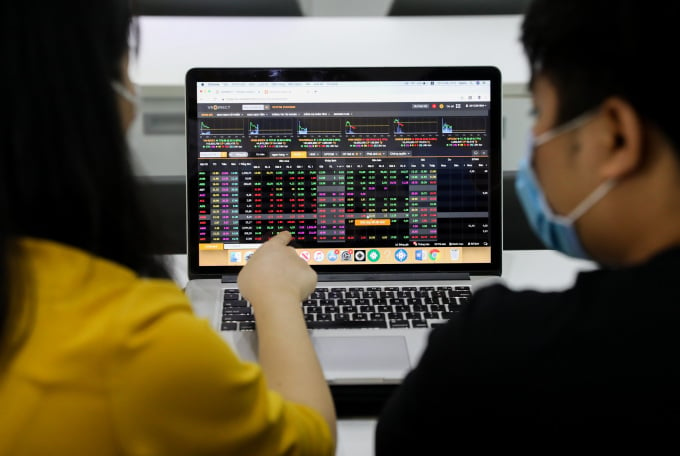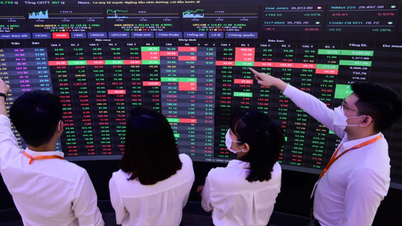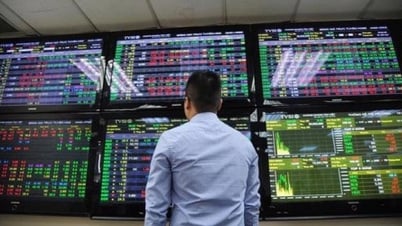According to experts, each person needs to determine their risk appetite, find investment methods and learn about market overview, industry, and business analysis.
I have recently learned about the stock market. Everything is so complicated that I want to learn this field thoroughly, then put some capital to "practice" (accept the loss), then consider long-term investment.
I would like to get expert advice on the roadmap from learning about stocks to the trial stage and officially entering the market. At each stage, what should I focus on or pay attention to?
Tran Quang Ngoc

Investors monitor the market at a stock exchange in District 1, Ho Chi Minh City. Photo: Quynh Tran
Consultant:
Securities in general and stocks in particular are very attractive investment channels, attracting many investors of all ages. This is an investment channel with many benefits, the most prominent of which is liquidity, and can start with small and medium capital.
Here, I will temporarily understand your need to invest in stocks and want to know more about the roadmap and how to learn to invest in stocks. To participate in the market successfully and effectively, you have determined to invest in knowledge to help yourself make the right and appropriate decisions. So where should learning start?
In my opinion, if you study without doing, it will be easy to get bored and have difficulty concentrating. Therefore, my first advice is that you should have a securities account and get familiar with the basic functions of the market because "the best teacher for you is the market". Don't wait until you finish studying to participate because it may be too late and learning is a lifelong task.
But before you start investing, you need to clearly define your risk appetite. Risk appetite is each person's perspective and level of acceptance of risk. Risk appetite is often determined by factors such as age, financial capacity, and family. The level of risk appetite will determine the safety of your capital and your expected return. For example, if you invest 100 million VND, how much will you accept to lose if the investment fails? With the risk level at the determined level, what percentage of profit do you expect to earn to compensate for the risks you may encounter?
Once you have determined your risk appetite, investment time horizon, financial capacity and financial backup plan, the next step is to start choosing some effective methods and learning methods. Some prominent methods are value investing, technical analysis investing, and growth investing.
Finding the right investment method for you will be quite easy if you have determined your risk appetite. Many methods can be applied to investment, but the most important thing is to find the method that suits your personality as well as how to apply it to the market to get the highest profit. At this point, you can practice buying and selling stocks on the floor and learn the basics of matching prices, indexes, stock price lists, and trading volume.
In terms of learning, in addition to the market as the "teacher", individual investors often explore and practice by themselves through books, online documents, foreign textbooks and practical experience. However, this way of learning often brings a lot of knowledge in a "picked up" manner that lacks systematization. In the long run, it will lead to many gaps and insufficient depth of understanding. Most importantly, you will lack systematization in your knowledge, which can lead to making wrong investment decisions.
Therefore, I often encourage new investors entering the market to follow a unified, comprehensive market roadmap to fully understand all aspects of investing as well as how the economy operates, thereby making the most informed investment decisions.
There are two main factors that determine investment: choosing the right stocks and the right time to buy and sell stocks. These factors will be summarized through learning the skills of selecting and analyzing investments in accordance with the macro context of the economy.
Below is a roadmap you can refer to. First, learn an overview of the Vietnamese stock market, understand the role and components of the market, and investment schools. Thoroughly understanding the smallest issues such as how profitable the market is, how buy and sell orders are set up will be very important in the first steps when you first participate.
Understanding macro and economic cycles is the next step you need to add. Determining the macro, the current economic cycle and the interaction between macro and industries in the market will give you the most accurate view of when to disburse investments, which industries, and what expectations.
Industry is an important part to focus on understanding. Money flow in the financial market will rotate between industry groups very flexibly. Understanding the industry, value chain, competitive advantage will give you a great advantage in capturing the cycle sooner or later through characteristic signs.
One of the final steps is to learn about the business, in which understanding the business's finances will be the final filter in making investment decisions. Reading and analyzing financial statements is to learn about the health and advantages of businesses in the industry, determine the rate of return, and the level of risk to choose and decide to invest.
Finally, equip yourself with knowledge about other activities such as buying and selling treasury stocks, preferred stocks, issuing ESOPs, splitting corporate stocks, valuation methods, investment schools... to further improve your knowledge.
Stocks are a highly profitable investment channel but also very risky. Therefore, invest seriously, have a strategy and always learn continuously to achieve worthy results.
Pham Hoang Quang Kiet
Deputy Head of Investment Research and Analysis
at FIDT Investment Consulting and Asset Management Company
Source link



![[Photo] Vietnam shines at Paris International Fair 2025 with cultural and culinary colors](https://vphoto.vietnam.vn/thumb/1200x675/vietnam/resource/IMAGE/2025/5/4/74b16c2a197a42eb97597414009d4eb8)
![[Photo] Bus station begins to get crowded welcoming people returning to the capital after 5 days of holiday](https://vphoto.vietnam.vn/thumb/1200x675/vietnam/resource/IMAGE/2025/5/4/c3b37b336a0a450a983a0b09188c2fe6)
![[Photo] General Secretary To Lam receives Sri Lankan President Anura Kumara Dissanayaka](https://vphoto.vietnam.vn/thumb/1200x675/vietnam/resource/IMAGE/2025/5/4/75feee4ea0c14825819a8b7ad25518d8)



























































































![[Video]. Building OCOP products based on local strengths](https://vphoto.vietnam.vn/thumb/402x226/vietnam/resource/IMAGE/2025/5/3/61677e8b3a364110b271e7b15ed91b3f)




Comment (0)